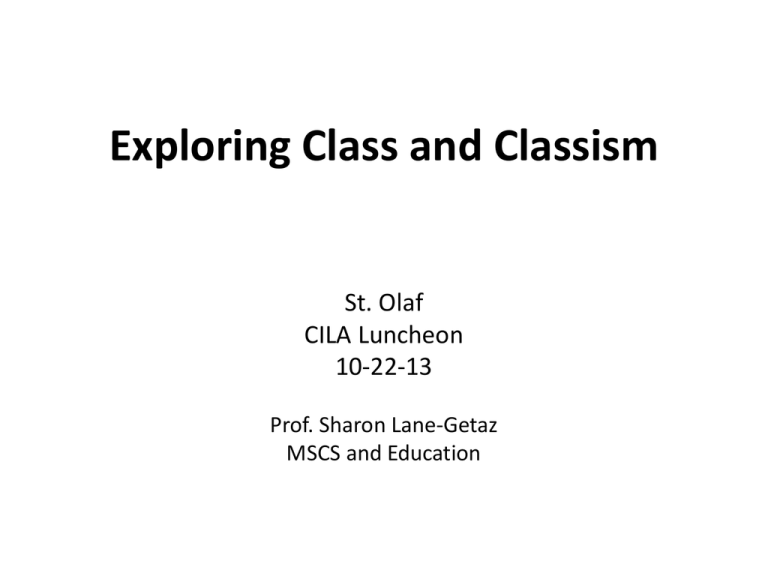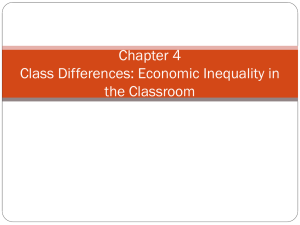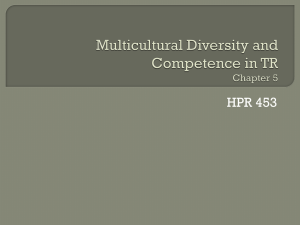Exploring Class and Classism
advertisement

Exploring Class and Classism St. Olaf CILA Luncheon 10-22-13 Prof. Sharon Lane-Getaz MSCS and Education Classism in the News… Steve Sack, Minneapolis Star Tribune, September 21, 2013 Exploring Class and Classism • Ground Rules and Definitions – “Ground Rules” – What do we mean by “class?” – What do we mean by “classism?” • Identify the social class in which we were raised • Identify strengths/limitations of our social class • Share how our social class shaped our world • Wrap up I. “Ground Rules” and Definitions “Ground Rules” • We agree that we are born into our class status: no blame, no shame, and no credit! • We agree that each social class has strengths and limitations. • We agree to be confidential about all we share today. • We agree to be honest, respectful and sensitive to each other. What do we mean by “class?” • Class is a relative social rank in terms of income, wealth, property ownership, job status, education, skills, or power in the economic and political sphere. • Class is determined not just by “economic capital” (what you earn or own) but also by “social capital” (who you know) and “cultural capital” (what you know). • Class identity affects us on the personal and emotional level, not just in economic terms. • Class influences how we feel about ourselves and others. Source: Class Action, www.classism.org What do we mean by “classism?” • Classism is when someone is treated differently—better or worse—because of their class (or perceived class). • Classism is similar in many ways to racism, sexism, heterosexism and other forms of oppression. • Classism appears individually through attitudes and behaviors, institutionally through policies and practices, and culturally through norms and values. • Classism is the tendency to make generalizations or stereotypes about people, such as “Poor people are lazy.” Source: Class Action, www.classism.org II. Identify Your Social Class at age 10 • Think of answers to the following questions based on your family situation when you were 10 years old (not now). • Move to a station (numbered) in the room based on your answer to each question. • Stop and look around you after each question. • As you shift between stations, who is with you? Does this change from question to question? Source: Class Action, www.classism.org Identifying Social Class, Question 1: What was your parents’ (either mothers’ or fathers’) level of education when you were 10? Station: 1 – Less than high school 2 – High school 3 – Associate degree / technical training 4 – College 5 – Masters, Professional certifications 6 – Advanced degree(s) Source: Class Action, www.classism.org Identifying Social Class, Question 2: What type of work did your parents do (either mothers or fathers) to earn income when you were 10, if anything? Station: 1 – Unskilled labor/Minimum wage jobs, unemployed 2 – Skilled / blue or pink collar worker 3 – Salaried / manager (factory management, secretary) 4 – Professional career (teacher, nurse, manager, lawyer) 5 – Top managers, partners, doctors, government officials 6 – Inheritance/investment (CEO, stockholder) Source: Class Action, www.classism.org Identifying Social Class, Question 3: How would you best describe your family home at age 10? Station: 1 – Public housing, homeless shelter, lived with others 2 – Rental housing 3 – Owned home 4 – Owned home and could/did trade up 5 – Owned multiple residences 6 – Inherited home(s) and properties Source: Class Action, www.classism.org Consider stations most occupied, your Social Class is… 1 – Low income / poor 2 – Working class 3 – Working middle class 4 – Professional middle class 5 – Upper middle class 6 – Owning class Source: Class Action, www.classism.org III. Strengths/limitations of your Social Class Within your class groups appoint a scribe to take notes to share about your group discussion with the large group. What can you come to agreement on concerning … 1. What you all have in common. 2. The key strengths or advantages of growing up in your class. 3. The key limitations or disadvantages of growing up in your class. (~15 minutes) Source: Class Action, www.classism.org IV. How has social class shaped your world? Report back about what your group had in common, your key strengths and limitations of growing up in your social class. What have we learned? (~15 minutes) Source: Class Action, www.classism.org Parting thoughts… • Americans believe we live in a “classless society.” • About 80%-90% of the US population consider themselves middle class. • The US social class breakdown is: Low income and poor ~20% Working class, blue or pink collar ~30% Working middle and professional ~40% Upper middle class ~ 7% Owning class ~2-3% Class Action, www.classism.org George Lakey, http://www.trainingforchange.org/george_lakey What can we do to end classism? • Change our attitudes and class consciousness • Support a fair economy without extremes of wealth and poverty • Uproot racism, sexism, and class oppression which perpetuate the status quo • Eradicate classism in institutions, policies, and politics Ideas for starting to level the playing field… • View the (Sept 2013) TED Talk: How to keep the plutocracy from becoming an aristocracy: Q&A with Chrystia Freeland. http://blog.ted.com/2013/09/05/how-to-keep-the-plutocracy-frombecoming-an-aristocracy-a-qa-with-chrystia-freeland/ • Refer to the Class Action web site (“Action” section): www.classism.org Resources • Lakey, George. Director, Training for Change http://www.trainingforchange.org/george_lakey • Leondar Wright, Betsy. Program Director, ClassAction, 30 Germania St, Building L, Jamaica Plain, MA 02130 www.classism.org • Sack, Steve. Political cartoon: http://portside.org/2013-09-21/how-incentives-work









